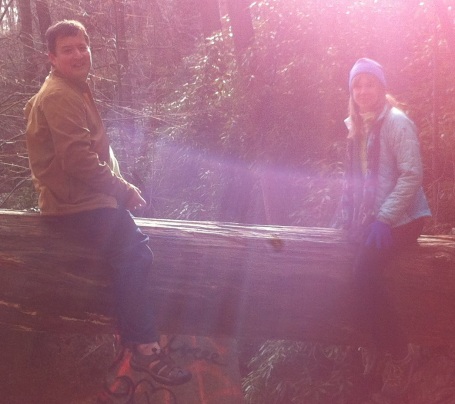If my husband Paul had his druthers, we would skip Christmas. Which really isn’t an option, since we have teenagers and a 5 year old niece in the house. But I get where he is coming from. We are in the midst of first year anniversaries of the most bizarre 3 months in our lives, events that are “Lifetime Movie of the Week” weird enough to suck the Advent/Christmas joy out of anyone.
This stretch between Thanksgiving and New Year’s can be tough for lots of reasons. We know that. But this first year in our house, I’m wondering how do you mark the anniversary of a homicide and suicide in the family?
Last Thanksgiving was the last time we were all together, with Paul’s aunt Carolyn and cousin John at our table. So that’s the beginning of the end of the firsts. Then the second week in December was the last time she was with her siblings, including Paul’s mother. Do we mark the day Carolyn was shot in late December? Or three days later, when we found out she was shot? Or the week we flew to Florida for her funeral and were interviewed by detectives? Or the day we discovered yes, John had owned a gun? Or the out-of-body experience of telling our kids what to do if John came to the door – that is, run upstairs and call the police but do NOT LET HIM IN. Or the day John shot himself in mid-January? Or the day we found out John shot himself? Or the first day we cleaned out his apartment, or the last day? Or the day just last week when the last of his furniture made it out of our garage? Whew. No wonder Paul doesn’t want to celebrate Christmas.
But here’s the challenge: Skipping Advent and Christmas and decorating and gift giving- it’s not an option, not this year. And so here is what I am doing to help us do more than just grit our teeth and get through this time. I don’t want John to take this, too. Maybe some of these will help you, should you find yourself with someone who is dragging through these days.
1. I’ve tried to get him talking. It had not occurred to him he was feeling this way for a very legitimate and real reason, called “grief.” I know, it’s so obvious to any outsider. But it wasn’t to him, in the middle of it. To him, “grief” didn’t seem to fit this situation, but it’s the best word we’ve got, and this is what it feels like and looks like. Just naming it keeps it from poisoning all of us like an invisible toxic cloud. Pointing it out weakens it’s power. Neuroscience tells us naming an emotion moves energy into the prefrontal cortex where thinking happens, reducing the energy left for namelessly feeling bad. It helps us feel better just to have a reason why we’re feeling so bad.
2. I’ve tried to schedule time with friends who make us laugh. Emotions are contagious. It’s been said many times, many ways, but we’re wired to connect, and part of connecting means our faces mimic the expressions around us, which then bring on the feelings mirrored by those expressions. Whole sections of our brains are devoted to figuring out what other people are feeling, which then makes us vulnerable to those feelings. So, I’m trying to schedule time for myself and my family with the happiest, silliest, people I know. I don’t mean “polly-anna-types.” I mean genuinely make you laugh every time you are with them folk. Even if we fake it, smiling makes us feel better. At the very least, it will improve my mood, which will then make me less vulnerable to the toxic cloud.
3. Even if it’s just going through the motions, we’re doing the traditional. Our brains are also wired like Pavlov’s dogs – Okay, more complicated than that, but still – We too can be trained to salivate when a bell is rung before a treat is awarded. So, picking up a Christmas ornament and putting it on a tree – Those motions of hand and arm and feet – Along with the smell and sight of a tree, the feeling of the ornament – Even the annual cursing of the tangled lights – It is all connected with all those memories of years we’ve done this before – Years that weren’t so hard. Years that maybe, were good. And a glimmer of that will rise to the surface.
4. We’re listening to music, and we’re going to church and singing hymns and we’re lighting candles. Yes, because of #3, but also music by-passes our logical, rational linear cognitions, Singing forces us to breath deeply and rhythmically, calming our nervous system. Lighting candles, yes, see #3 again, but also, it reminds us there is light even in the darkest of times; even when it doesn’t feel like that light can pierce our sadness, part of our brain does register this act of faith. Our eyes are made to seek out light.
And 5: I’m keeping expectations low, and I’m not trying to talk anyone out of how they are feeling. It would be hard to top the drama of last year, which means as my sister says, it’s hard to imagine a stranger year of first anniversaries. We will probably have hard Christmases in the future, but odds are they will be of the normal grief and sadness of missing loved ones. Not the endless looping of “What did we miss? How did this happen? Why did this happen? How can I make sense of this?” One thing about terminal cancer, it’s hard, but it’s straightforward, and most everyone gets it.
This is not to say we should ignore, belittle, or minimize the grief that may knock on the door. There will be tears. That’s okay. That’s real. But we can still connect, and still love each other through the hard stuff, and maybe even see a tiny glimmer of hope, joy, love, peace. So, blessings on everyone who is walking with someone struggling this season – That is it’s own special hard. But maybe some of these tips will make us all a little less vulnerable to the crazy thoughts and feelings that show up, and a little more open to good surprises of the season.


